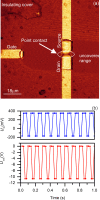Copper atomic-scale transistors
- PMID: 28382242
- PMCID: PMC5355937
- DOI: 10.3762/bjnano.8.57
Copper atomic-scale transistors
Abstract
We investigated copper as a working material for metallic atomic-scale transistors and confirmed that copper atomic-scale transistors can be fabricated and operated electrochemically in a copper electrolyte (CuSO4 + H2SO4) in bi-distilled water under ambient conditions with three microelectrodes (source, drain and gate). The electrochemical switching-on potential of the atomic-scale transistor is below 350 mV, and the switching-off potential is between 0 and -170 mV. The switching-on current is above 1 μA, which is compatible with semiconductor transistor devices. Both sign and amplitude of the voltage applied across the source and drain electrodes (Ubias) influence the switching rate of the transistor and the copper deposition on the electrodes, and correspondingly shift the electrochemical operation potential. The copper atomic-scale transistors can be switched using a function generator without a computer-controlled feedback switching mechanism. The copper atomic-scale transistors, with only one or two atoms at the narrowest constriction, were realized to switch between 0 and 1G0 (G0 = 2e2/h; with e being the electron charge, and h being Planck's constant) or 2G0 by the function generator. The switching rate can reach up to 10 Hz. The copper atomic-scale transistor demonstrates volatile/non-volatile dual functionalities. Such an optimal merging of the logic with memory may open a perspective for processor-in-memory and logic-in-memory architectures, using copper as an alternative working material besides silver for fully metallic atomic-scale transistors.
Keywords: electrochemistry; encapsulation; metallic atomic-scale transistor; nanotechnology; photolithography.
Figures







References
LinkOut - more resources
Full Text Sources
Other Literature Sources
